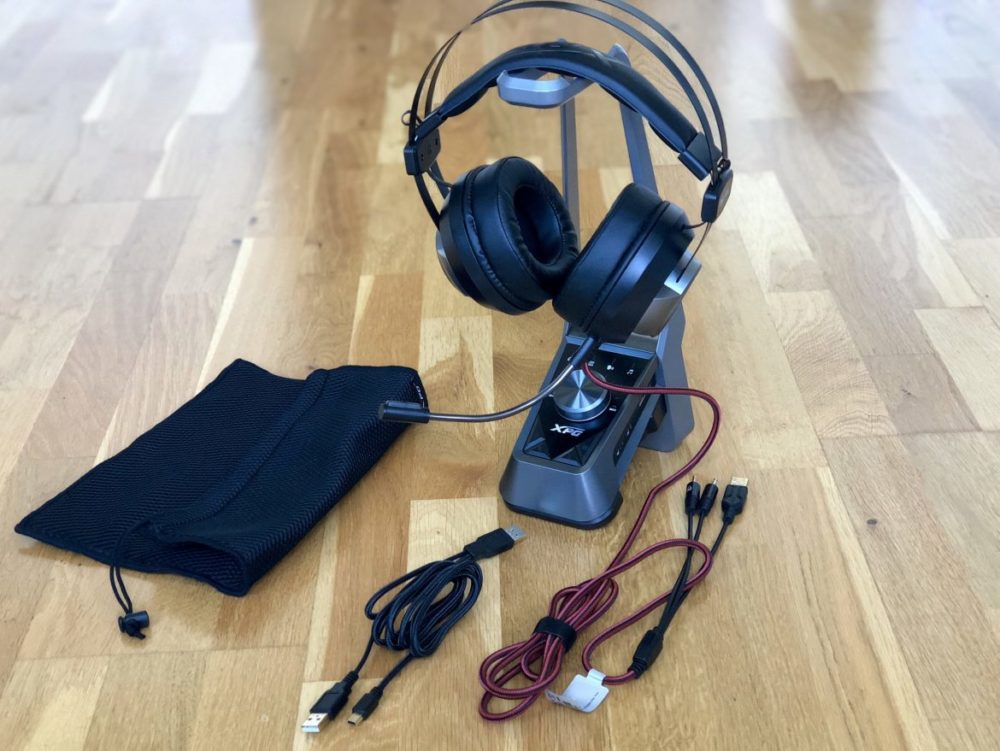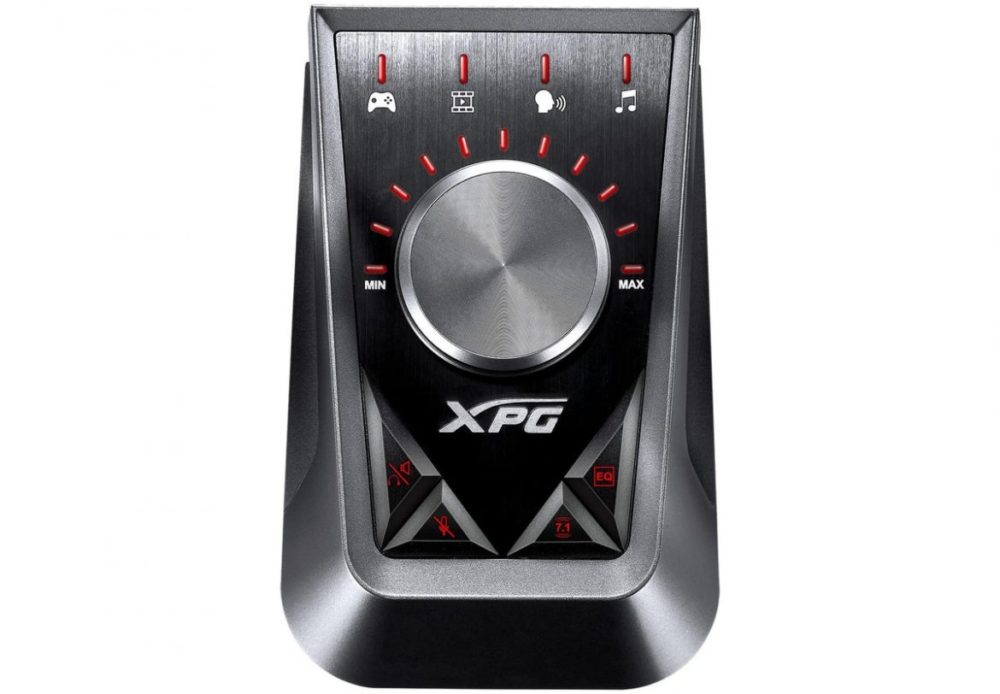TL;DR
ADATA's XPG EMIX H30 headset and SOLOX F30 DAC offer a comfortable fit and decent sound, with a strong bass presence, making them a viable option for PC gamers seeking an enhanced audio experience with virtual 7.1 surround. While it works for Mac and PS4 users, functionality is reduced, and the USB 2.0 connections feel dated. Xbox One users are largely out of luck due to compatibility issues. The inability to disable EQ modes and the plastic construction are minor drawbacks. Discover if this package hits the right notes for your setup by diving into the full review!
Note: This review has been updated with new and, in some cases, corrected information.
The manufacturer ADATA is primarily known for hard drives, memory, and graphics cards. However, the Taiwanese company is expanding its presence in the Nordic region with the release of its first audio kit, the XPG EMIX H30 gaming headset and the SOLOX F30 DAC amplifier. This move is reminiscent of Kingston’s success with their acclaimed HyperX Cloud headsets. This package presents an interesting option for PC gamers and, to some extent, PS4 users, although its appeal may be less pronounced for Mac and Xbox One owners.
The package containing the components is substantial. The Emix H30 are wired over-ear headphones, offering a comfortable fit and weighing approximately 400 grams, which is typical for this type of headset. They feature relatively large, 53mm dynamic drivers with a maintained impedance of 32 Ohms (for a deeper understanding of headphone technology, please refer to the senses headphone school). Audio is transmitted via a 2.4m long, braided cable terminating in three connectors: two 3.5mm RCA connectors for headphone and microphone functions, and a USB 2.0 connector for the DAC (Solox F30). Also included is a flexible, detachable microphone that easily connects to the left earcup, along with a carrying bag. The DAC (which functions solely as an amplifier, not a combined sound card like the Soundblaster Play! 3) connects via a Y-split USB 2.0 cable for simultaneous audio and power transfer. A more streamlined solution utilizing modern USB-C connections would have been preferable. The Solox F30 provides virtual 7.1 surround sound (on PC) and EQ modes for film, games, speech, and music. Notably, there isn’t a neutral mode to disable the EQ entirely. The unit also includes a mute button and volume knob. The overall design is clean and well-organized, and a compact hanging rack is included for storage. However, this is not a gaming set designed for portability.
The design exhibits a clean and deliberate aesthetic, and the straightforward button layout on the DAC is commendable. The operation is intuitive and requires no manual. However, the extensive use of plastic, while of good quality, detracts from a premium feel. With a price point of approximately 1800 SEK at the time of testing, it’s neither inexpensive nor overly expensive. This puts it in a competitive segment with established brands such as Plantronics and SteelSeries, many of whose products also feature predominantly plastic construction. Metal is limited to the headphone arch and the stand, which are both stylish and robust.
Generous Bass, Acceptable Resolution
What is the sound quality of the Emix H30? It’s actually quite good. Expect a generous bass response which, when paired with the appropriate EQ mode, delivers depth without becoming muddy. The overall warmth of the sound is comfortable for extended gaming sessions. While not our top choice for music listening due to a slight lack of clarity in the midrange, the performance is acceptable for the price range. (The bass sounds too muffled in music mode, so we recommend the speech or movie setting). As mentioned, virtual 7.1 surround is only available on PC (while it can be enabled on Mac, its effect is negligible). As we do not currently cover PC audio on senses, fully testing all features initially posed a challenge. However, through a loaner PC from one of our partners, we were able to evaluate the headphones for over a month this summer. The software is functional and intuitive. The DAC provides a slight enhancement to sound quality, and the virtual 7.1 surround sound attempts to simulate a spatial audio experience, potentially providing some benefit in FPS games. In general, we find that artificial sound enhancement modes detract from overall sound quality, which also applies to the pre-programmed EQ modes. A key issue with the Solox F30 is the inability to completely disable the EQ mode; it must always be set to one of the four presets. The rationale behind this design choice is unclear. Ideally, users should have the option to bypass all enhancements and utilize a neutral setting. Ultimately, audio preference is subjective, and some users prefer heavily enhanced audio profiles. However, the option for a clean, unadulterated signal should always be available.
The detachable microphone provides clear audio with minimal noise. However, it does exhibit some sensitivity to ambient sound, although this is not a significant issue. A more substantial problem is the microphone’s reliance on a separate 3.5mm connection, rendering it unusable on Xbox One due to the controller’s single 3.5mm jack (which is required for both audio output and input). The DAC also lacks an optical input. Unlike the PS4, the Xbox One cannot transmit audio via USB, which is unfortunate for Xbox One owners considering this package. The necessity for three connections for full functionality also feels dated in 2018.
Functionality
PC
PC users benefit from the most comprehensive feature set when using the Emix H30 and Solox F30, offering access to the Xear software for sound customization and firmware updates that can potentially improve performance. The 7.1 virtual surround sound provides a simulated spatial audio experience that can enhance the sense of immersion in FPS games and movies.
Mac
Mac users have the second-best experience. The device functions immediately upon connection via USB, but lacks the Xear software and firmware update capability. This is similar to many of Creative’s speakers. The 7.1 virtual surround button provides a subtle adjustment to the soundstage, but its effect is minimal. The microphone functions as expected, and its levels can be easily adjusted via the Mac’s built-in interface.
PS4
Initially, we encountered difficulties getting the package to function with the PS4. However, after a console firmware update, the kit could be activated via the system menu (Devices – Sound – USB). The DAC occupies two USB ports, limiting its connection to the front of the console unless an external USB hub is used (ensure the hub provides sufficient power). Both sound and microphone function properly, and levels can be adjusted via the PS4’s built-in interface. Virtual 7.1 surround sound is not supported.
Xbox One
Unlike the PS4, the Xbox One S and X feature USB ports on the rear, but the connection is fundamentally limited. The Xbox One (all models) cannot transmit audio via USB and requires an optical cable connection. An optical cable is not included, and even if it were, the DAC lacks the necessary optical input. The reasoning behind this design choice by ADATA remains unclear. The manual and website offer no explanation. While the headphones can be used for audio output via the controller, this negates the benefits of the microphone and DAC, rendering the package redundant (the headphones can be purchased separately).
Another minor drawback is the fixed earcups. Wear and tear will require replacing the entire headphones instead of only the cushions.
Summary
The Emix H30 + Solox F30 package presents a mixed experience dependent on the intended platform. The headphones provide a comfortable fit and decent sound quality across all formats. The inclusion of a functional DAC and a stand for organization is a positive aspect of ADATA’s design. However, the reliance on USB 2.0 and multiple cable connections feels somewhat outdated. PC owners receive the full benefit of the package and appear to be the primary target audience, while Mac and PS4 users experience slightly reduced functionality. The Xbox One compatibility is significantly limited and not recommended (we will update this review if we receive clarification from ADATA regarding Xbox One compatibility, but they have not yet responded to our inquiries).
If you are a PC, PS4, or Mac user seeking a gaming headset with a straightforward amplifier that can switch between sound modes, headphones, and speakers, the Emix H30 + Solox F30 is a viable option. However, competing products in the same price range offer comparable or superior performance (for example, if a DAC with EQ is not required, the Plantronics 800HS provides better sound on the PS4, and is also wireless and cheaper). The lack of dedicated software for Mac users to control the DAC, EQ, and sound settings is a notable drawback. Xbox One users should consider alternative options due to the limited functionality.
In conclusion, this is a satisfactory sound package for PC users, reasonably good for Mac and PS4, and currently unsuitable for Xbox One.


